The European Union plant-based eggs sector is projected to advance from USD 35.8 million in 2025 to nearly USD 179.6 million by 2035, reflecting a CAGR of 17.5%. The growing demand for plant-based eggs shows alternative protein categories are gaining traction in everyday diets across Europe. Plant-based egg substitutes are no longer limited to niche vegan communities but are increasingly being incorporated into mainstream meal preparation, bakery formulations, and foodservice offerings. The rising influence of plant-based nutrition, ethical food choices, and the preference for cruelty-free products have positioned this category as a disruptive force in the European food and beverage landscape.
Sales of plant-based egg alternatives in the European Union are projected to rise by USD 142.6 million between 2025 and 2035, growing from USD 35.8 million to USD 179.6 million. This expansion represents 398.3% total growth, with the market forecast to expand by nearly 5.0X during the assessment period. Multiple factors, including consumer adoption of vegan diets, flexitarian lifestyles, and plant-forward eating patterns, are fueling such extraordinary growth momentum. Increasing cases of egg allergies and the desire for cholesterol-free cooking options have also made plant-based substitutes attractive, particularly for health-conscious households.
The ingredient innovation pipeline is driving the rapid adoption of this category. Functional ingredients derived from mung beans, peas, chickpeas, and soy are being optimized to replicate the emulsification, foaming, and binding characteristics of conventional eggs. This functional versatility makes them suitable for bakery products, ready-to-cook meals, confectionery, and culinary applications. Foodservice operators are leveraging plant-based egg solutions to diversify menus, while retail shelves are witnessing growing penetration of liquid egg substitutes, powdered formulations, and fortified blends enriched with vitamins and minerals to mimic the nutritional value of poultry eggs.
Western Europe remains the most dynamic region for this category, with Germany, France, and the United Kingdom leading demand due to established retail distribution, strong consumer awareness, and broad acceptance of plant-based protein products. Southern European countries such as Spain and Italy are integrating plant-based eggs into bakery and traditional dishes, while Eastern Europe is emerging as a growth contributor as modern retail chains and specialty stores expand access. The European Union’s support for plant-based protein development and initiatives to reduce reliance on animal-derived foods are providing an additional boost to industry adoption. By 2030, plant-based egg substitutes are expected to become an integral part of the broader alternative protein ecosystem, reinforced by technological advances in shelf-stable powders, pre-mixed cooking solutions, and e-commerce-based distribution strategies. With consumers prioritizing clean-label products, ethical food sourcing, and environmentally responsible choices, the EU plant-based eggs sector is projected to remain one of the fastest-growing segments of the plant-based food industry throughout the forecast horizon.
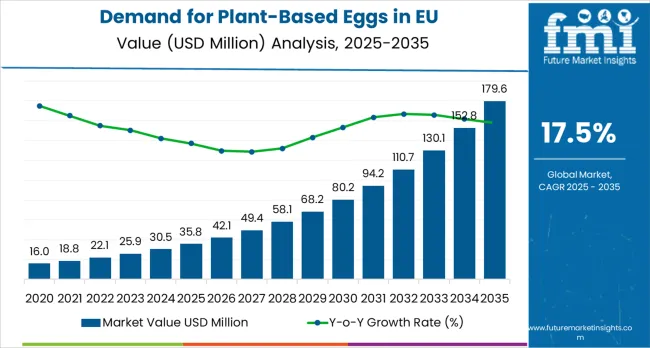
Between 2025 and 2030, the demand for plant-based eggs in EU is projected to expand from USD 35.8 million to USD 76.2 million, resulting in a value increase of USD 40.4 million, which represents 28.3% of the total forecast growth for the decade.
This phase of growth will be shaped by accelerating plant-based dietary trends across Western European markets, increasing consumer awareness of plant-based egg benefits and culinary versatility, growing adoption of sustainable protein alternatives, and expansion of specialty retail infrastructure in Eastern European economies.
Manufacturers are developing innovative product formulations including enhanced texture varieties, improved cooking performance, organic and allergen-free certifications, and sustainable packaging solutions to address evolving European consumer preferences for transparency, nutritional quality, culinary functionality, and environmental responsibility.
From 2030 to 2035, the market is forecast to grow from USD 76.2 million to USD 179.6 million, adding another USD 102.2 million, which constitutes 71.7% of the overall ten-year expansion. This period is expected to be characterized by widespread adoption of plant-based eggs across mainstream European retail channels, integration of advanced food technology for enhanced product development, development of application-specific formulations targeting culinary and foodservice markets, and expansion of premium organic and specialty product segments.
The growing emphasis on sustainable nutrition, increasing professional chef recommendations for plant-based alternatives, stringent EU regulations supporting food safety and labeling accuracy, and rising environmental consciousness across European consumer segments will drive sustained demand for nutritionally complete, functionally superior, and sustainably produced plant-based egg solutions.
Between 2020 and 2025, the demand for plant-based eggs in EU experienced robust expansion, driven by accelerating plant-based dietary trends that positioned plant-based eggs as essential alternatives for traditional egg consumption, sustainable cooking applications, and ethical food choices.
The market developed as European retailers and health-conscious consumers recognized commercial and nutritional opportunities in high-quality, functionally equivalent, and specialty plant-based egg formats that appealed to environmentally conscious consumers and professional chefs seeking optimal cooking performance and ethical sourcing for their culinary applications.
Major international plant-based food producers expanded distribution capacity through strategic retail partnerships in European markets, while regional players developed specialized formulations addressing specific taste preferences and cooking requirements across diverse national markets within the European Union.
Market expansion is being supported by the fundamental shift in consumer attitudes toward sustainable protein consumption and ethical food choices across European societies, with plant-based eggs increasingly regarded as superior nutritional alternatives deserving premium positioning, natural production methods, and overall functional benefits comparable to traditional eggs while providing unique environmental and ethical advantages.
Modern European consumers and professional chefs consistently prioritize ingredient sustainability, nutritional completeness, cooking performance, and ethical production when selecting egg alternatives, driving demand for specialty plant-based egg formulations that deliver superior culinary performance, natural processing methods, exceptional functional properties, and environmental certifications compared to conventional animal-based eggs.
Even minor concerns about animal welfare, environmental impact, or dietary restrictions can drive comprehensive adoption of specialized plant-based egg products designed to maintain optimal cooking functionality, support specific dietary applications, and enhance overall consumer satisfaction throughout all culinary categories.
The growing complexity of plant-based nutrition and increasing awareness of environmental impact are driving demand for professionally formulated plant-based egg products from certified European manufacturers with appropriate quality certifications, food technology capabilities, technical expertise, and compliance with stringent EU food safety regulations.
Regulatory authorities across European Union member states are increasingly establishing comprehensive guidelines for plant-based egg manufacturing, nutritional claim accuracy, labeling requirements, and food safety protocols to ensure product safety and functional efficacy.
Scientific research studies and culinary testing conducted at European food science research institutions are providing evidence supporting plant-based egg interventions for common cooking challenges including protein functionality, texture replication, nutritional density, and cooking versatility, requiring specialized formulation expertise and quality-controlled production processes that meet EU food safety standards.
The market is segmented by product type, distribution channel, and sales region. By product type, the market is divided into legume-based, soy-based, and other plant-based formulations. Based on distribution channel, the market is categorized into supermarkets (including hypermarkets and grocery chains), online retail (including e-commerce platforms and direct-to-consumer websites), and specialty stores (including health food retailers and organic stores). Regionally, the market covers Germany, France, Italy, Spain, Netherlands, and Rest of Europe.
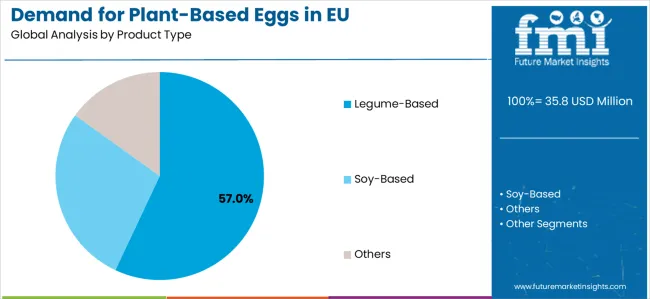
Legume-based plant-based eggs segment is projected to account for 57.0% of the Demand for Plant-Based Eggs in EU in 2025, establishing itself as the dominant product category across European retail and foodservice facilities. This commanding market position is fundamentally supported by the widespread adoption of legume proteins for superior nutritional profiles, excellent cooking functionality, and specialized dietary applications that deliver exceptional protein content, superior binding properties, and unparalleled cooking versatility throughout large-scale commercial operations across EU member states.
Legume-based plant-based egg products provide European food manufacturers with unparalleled nutritional customization, precise protein control during production processes, enhanced functional properties, and seamless integration with plant-based cooking trends that comply with stringent EU food safety directives.
This product sophistication enables European food technology companies to achieve optimal production economics while maintaining rigorous quality protocols mandated by European Food Safety Authority (EFSA) regulations, comprehensive traceability systems required under EU law, and consistent functional performance across millions of individual culinary applications produced annually.
The segment derives substantial competitive advantages from established European legume processing infrastructure offering specialized extraction solutions, comprehensive technical support services, and continuous product innovation that incorporates advanced protein technologies, improved cooking characteristics, and functional ingredient capabilities aligned with modern food technology standards.
The legume-based systems deliver superior nutritional positioning particularly important in health-conscious markets, enhanced protein profiles, improved consumer acceptance, and superior regulatory compliance with EU plant-based food standards.
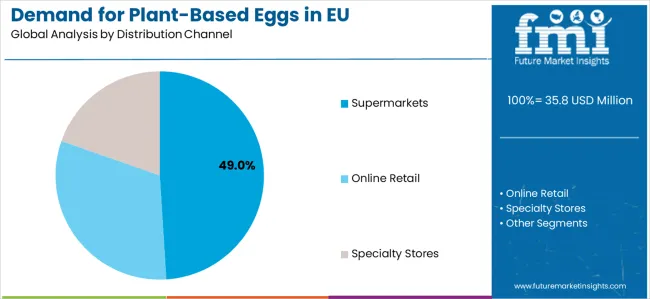
Supermarkets distribution channel is positioned to represent 49.0% of total European plant-based egg demand in 2025, reflecting the segment's dominant position within the overall market ecosystem and the substantially larger retail consumption patterns compared to other distribution categories across most European countries. This substantial market share directly demonstrates the exceptionally high adoption rates of plant-based eggs among European mainstream retailers and the continuously expanding population of environmentally conscious shoppers across both Western and Eastern European markets.
Modern European supermarket plant-based egg distribution is increasingly featuring sophisticated product assortments that deliver enhanced accessibility, competitive pricing strategies, and specialized merchandising approaches specifically designed to address common consumer adoption challenges including product awareness, cooking education, price comparison, and brand differentiation.
European supermarket chains consistently demonstrate willingness to invest substantially in plant-based egg categories that deliver visible sales performance, support optimal inventory turnover, comply with EU retail food safety standards, and provide consistent results for both large-scale retail operations and consumer satisfaction. Within the supermarkets segment, hypermarket chains command 25% share, grocery stores represent 15%, and premium retailers account for 9%, reflecting comprehensive retail segmentation strategies tailored to European consumer shopping preferences.
The demand for plant-based eggs in EU is advancing steadily due to intensifying sustainable nutrition trends and growing recognition of plant-based alternatives across EU member states. However, the market faces challenges including fluctuating raw material costs for specialty plant proteins, complex regulatory requirements for novel food approvals across diverse European jurisdictions, varying cooking performance characteristics across different formulations, competition from traditional eggs and other plant-based proteins, and varying consumer awareness levels across different EU countries despite growing plant-based trends. Innovation initiatives, organic certification programs, cooking education platforms, and personalized nutrition solutions continue to influence product development strategies and market evolution patterns across European markets.
The rapidly accelerating adoption of environmental consciousness and sustainable food choices is fundamentally enabling broader market penetration across European countries, enhanced brand positioning among consumers particularly regarding carbon footprint reduction, and significantly improved product acceptance through mainstream dietary integration.
Advanced sustainability education programs operated by specialized environmental organizations, professional nutritionists, and major food retailers equipped with comprehensive environmental impact information in multiple European languages, sustainability certifications, cooking guides, and personalized recommendations provide extensive educational resources while dramatically expanding product visibility across diverse consumer segments and geographic markets throughout the European Union.
These environmental trends prove particularly valuable for plant-based egg products that require detailed sustainability explanations, environmental impact documentation, and targeted marketing approaches to effectively communicate complex environmental benefits and justify premium pricing positions across sophisticated European environmentally-conscious segments.
Environmental consciousness also enables sophisticated consumer analytics, personalized sustainability recommendations based on individual dietary preferences and environmental values, direct consumer feedback collection that informs product development, and subscription models that ensure predictable revenue streams while reducing customer acquisition costs across fragmented European markets.
Progressive European plant-based egg manufacturers are systematically incorporating innovative food technologies including texture optimization, flavor enhancement, nutritional fortification, and cooking performance improvement that address growing European consumer demands for superior taste profiles, consistent cooking results, and enhanced nutritional density in plant-based alternatives.
Strategic integration of these advanced food technologies, combined with rigorous taste testing and functional validation protocols conducted at European food science institutions, enables manufacturers to develop differentiated product propositions that appeal to culinary-conscious European consumers while maintaining essential cooking performance and nutritional characteristics.
These technological initiatives also support development of specialized formulations for specific cooking applications increasingly recognized across European markets, enhanced flavor options for diverse taste preferences recommended by European chefs, and functional-benefit products that resonate with health-driven consumer segments particularly prevalent in Nordic and Western European countries.
Technology investments in food innovation facilities established in Netherlands and Germany, precision texture development capabilities, and advanced plant protein processing technologies enable European manufacturers to explore next-generation alternatives while maintaining competitive positioning in premium and ultra-premium market segments.
European consumers and retailers are increasingly prioritizing organic certifications and clean label formulations when selecting plant-based egg products, driving fundamental changes in sourcing strategies across the European plant-based food industry.
Companies are implementing comprehensive organic production systems using certified organic plant proteins, reducing ingredient complexity through natural formulation approaches, and developing fully traceable supply chains that align with EU organic directives and clean label regulations. This trend is particularly pronounced across Nordic countries, Germany, Netherlands, and France where consumers demonstrate exceptional ingredient consciousness and willingness to pay premiums for products with verified organic certifications and clean label credentials.
Manufacturers are responding by developing partnerships with certified organic protein suppliers, implementing clean label formulation programs, obtaining multiple organic certifications including EU Organic and natural product standards, and providing transparent ingredient information that differentiates their products in increasingly competitive European markets emphasizing ingredient purity and clean label commitments.
The demand for plant-based eggs in EU is projected to grow from USD 35.8 million in 2025 to USD 178.4 million by 2035, registering a CAGR of 17.5% over the forecast period. Germany is expected to maintain its leadership with a 32.1% share in 2025, supported by its expansive plant-based food retail infrastructure and strong tradition of sustainable food consumption.
France follows with a 19.6% market share, attributed to growing demand for premium and organic plant-based alternatives. Italy contributes 13.4% of the market, driven by increasing adoption in culinary and dietary applications. Spain accounts for 8.9% of the market, while Netherlands represents 5.6%. The Rest of Europe region holds the remaining market share, encompassing Nordic countries, Eastern Europe, and other EU member states with emerging demand for plant-based egg products.
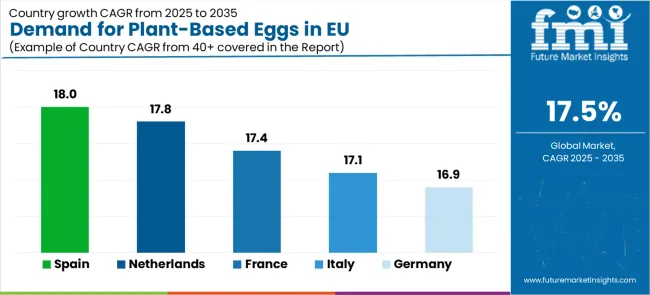
| Country | CAGR (2025 to 2035) |
|---|---|
| Spain | 18.0% |
| Netherlands | 17.8% |
| France | 17.4% |
| Italy | 17.1% |
| Germany | 16.9% |
The demand for plant-based eggs in EU demonstrates strong growth across major economies, with Rest of Europe leading at an 18.2% CAGR through 2035, driven by rapidly expanding plant-based dietary adoption and growing environmental consciousness. Spain follows at 18.0%, supported by strong sustainable food culture and Mediterranean wellness traditions.
Netherlands grows at 17.8%, integrating plant-based eggs into advanced sustainable nutrition practices. France and Italy record 17.4% and 17.1% respectively, emphasizing organic standards and culinary applications. Germany maintains steady growth at 16.9%, leveraging its established plant-based food infrastructure. Overall, Germany maintains its leadership position while Rest of Europe emerges as the fastest-growing market for plant-based egg adoption.
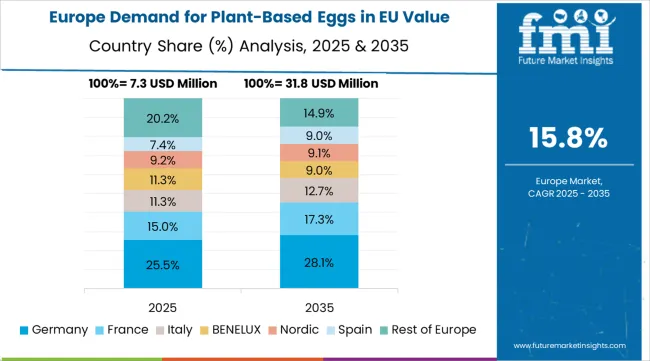
The plant-based eggs industry in Germany is projected to exhibit steady growth with a CAGR of 16.9% through 2035, driven by exceptionally strong consumer tradition in sustainable food products and plant-based alternatives, comprehensively well-established distribution networks for organic and specialty plant-based products, and sophisticated regulatory frameworks supporting novel food standards throughout the country.
Germany's advanced food safety regulations and internationally recognized organic certification standards through organizations including German Organic Food Association are creating substantial demand for certified organic and specialty plant-based egg products across diverse professional and consumer segments.
Major retail chains including REWE, Edeka, specialized organic retailers including Alnatura, and professional distribution networks are systematically establishing extensive product portfolios serving both health-conscious consumers and commercial food manufacturers throughout German urban centers, suburban areas, and rural communities. The German market benefits from exceptionally high consumer awareness of sustainable nutrition, substantial plant-based food retail presence, strong private label programs delivering quality at accessible price points, and cultural emphasis on environmental responsibility that naturally support premium plant-based egg adoption.
The plant-based eggs industry in France is expanding at a robust CAGR of 17.4%, substantially supported by increasing French consumer interest in sustainable cooking and premium organic ingredients, rapidly growing awareness of plant-based egg culinary applications, and sophisticated appreciation for innovative food technology reflecting French culinary culture. France's exceptionally well-established culinary tradition and premium positioning strategies across retail sectors are systematically driving demand for high-quality plant-based egg products across diverse culinary and health-focused segments.
Specialized sustainable food suppliers including Naturalia, traditional organic food retailers, major hypermarket chains (Carrefour, Auchan, Leclerc), and professional culinary schools are establishing comprehensive product ranges featuring premium imported and French-produced plant-based eggs emphasizing organic certification and culinary versatility. The French market particularly benefits from strong cultural emphasis on culinary innovation, sustainable cooking techniques, and natural ingredient traditions that align perfectly with plant-based eggs positioning as essential culinary enhancement and sustainable protein alternatives.
The plant-based eggs industry in Italy is growing at a consistent CAGR of 17.1%, fundamentally driven by gradual integration of plant-based eggs into traditional Italian cooking patterns, growing recognition of sustainable nutrition benefits, and strong Italian cultural appreciation for authentic ingredients and natural food enhancement. Italy's deeply established food culture is gradually incorporating plant-based eggs to enhance traditional recipes, improve nutritional profiles, and modernize classic Italian cooking approaches while maintaining authentic regional characteristics.
Health food stores, specialized organic retailers including NaturaSì, leading grocery retailers (Coop, Esselunga, Conad), and traditional neighborhood suppliers are strategically investing in education programs and culinary demonstrations addressing growing Italian interest in plant-based nutrition solutions. The Italian market particularly benefits from strong cultural appreciation for ingredient authenticity, traditional family-oriented cooking approaches reflecting close cultural food traditions, and growing disposable income particularly in Northern Italian regions supporting premium organic product adoption.
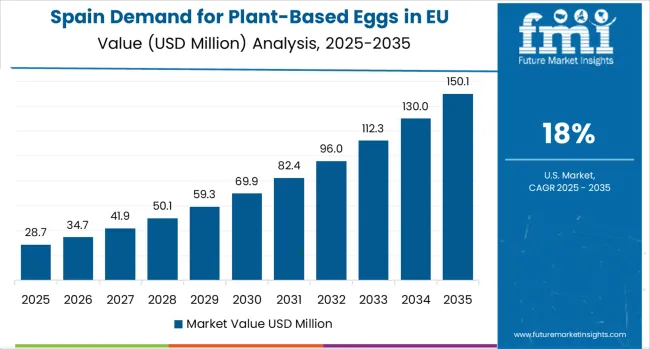
Demand for plant-based eggs in Spain is projected to grow at a strong CAGR of 18.0%, substantially supported by rapidly expanding health consciousness and sustainable dietary adoption, increasing Spanish consumer awareness of environmental benefits, and growing disposable incomes particularly in major metropolitan areas including Madrid, Barcelona, Valencia, and Seville.
Spanish sustainable food sector is experiencing significant modernization with expansion of organic retailers, premium alternative protein suppliers, and major grocery retailers (Mercadona, Carrefour España, Día) systematically increasing plant-based food category space allocation and introducing premium plant-based egg brand assortments.
The Spanish market is increasingly characterized by premiumization trends reflecting broader European patterns, growing interest in functional nutrition formulations addressing specific dietary requirements, and increasing acceptance of higher price points for quality sustainable alternatives delivering visible environmental benefits.
Spain's substantial health and wellness focus, strong cultural appreciation for natural food solutions reflecting Mediterranean values, and expanding middle-class purchasing power create favorable conditions for premium plant-based egg market expansion.
Demand for plant-based eggs in the Netherlands is expanding at a strong CAGR of 17.8%, fundamentally driven by exceptionally strong Dutch consumer commitment to sustainable food products, premium plant-based alternatives, and environmental consciousness that positions Netherlands among European sustainability leaders.
Dutch consumers and food professionals are increasingly selecting plant-based eggs based on comprehensive environmental certifications, verified sustainable production methods, and complete supply chain transparency documenting environmental impact and ethical sourcing practices throughout production processes.
The Netherlands market significantly benefits from exceptionally well-developed sustainable retail channels including Jumbo, Albert Heijn, specialized organic retailers including Ekoplaza, and professional sustainable food suppliers, combined with demonstrated willingness to pay substantial premiums for products with verified environmental certifications and sustainability standards.
Dutch regulatory environment actively supports sustainable food production, innovative manufacturing practices, transparent labeling requirements, and circular economy initiatives that enhance consumer confidence and market development.
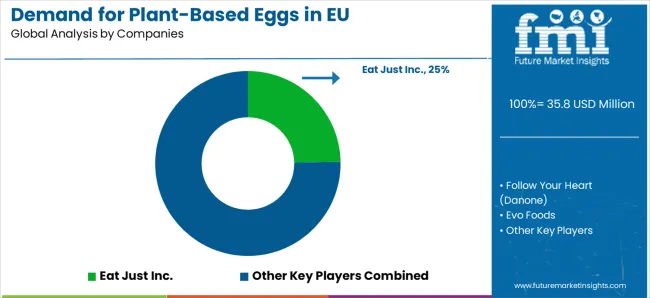
The demand for plant-based eggs in EU is defined by intense competition among multinational food technology companies, regional European manufacturers, specialized plant-based producers, and private label suppliers from major retail chains.
Companies are investing in European production capacity expansion, advanced food technology development, organic certification programs through European regulatory bodies, sustainable production solutions aligned with EU environmental directives, and direct-to-consumer distribution platforms serving diverse European health-conscious markets.
Strategic acquisitions, product portfolio expansion, geographic market penetration across Eastern European growth markets, professional chef partnership programs, and organic certifications are central to strengthening market position and capturing share in this dynamic European category.
Major market participants include Eat Just Inc. with significant European market presence through mung bean-focused formulations and innovative food technology capabilities distributed through European retail channels. Follow Your Heart (Danone) maintains substantial European market leadership through strong retail network integration and diverse product applications across mainstream and specialty markets.
Evo Foods represents growing European market penetration through India-centric innovation and competitive pricing strategies. Crackd emphasizes premium UK retail positioning and technical support services for specialized applications across European markets.
Regional European producers and specialized organic brands are establishing significant market presence through premium organic positioning, EU organic certifications, specialty product formulations including allergen-free and enhanced-nutrition varieties, and direct-to-consumer business models.
Private label programs from major European retail chains including REWE, Carrefour, Tesco, and specialized organic suppliers provide quality alternatives at competitive pricing, capturing meaningful market share particularly in price-sensitive sustainable food markets. European co-manufacturing specialists including specialized food technology producers operate innovative production facilities serving both branded manufacturers and private label customers, representing critical infrastructure enabling market expansion and product innovation across European plant-based food markets.
| Item | Value |
|---|---|
| Quantitative Units | USD 179.6 million |
| Product Type | Legume-Based, Soy-Based, Others |
| Distribution Channel | Supermarkets, Online Retail, Specialty Stores |
| Countries Covered | Germany, France, Italy, Spain, Netherlands, Rest of Europe |
| Key Companies Profiled | Eat Just Inc., Follow Your Heart (Danone), Evo Foods, Crackd, Simply Eggless, Zero Egg, European Regional Producers, Private Label Suppliers, Specialty Organic Brands, Food Technology Innovators |
| Additional Attributes | Dollar sales by product type and distribution channel, regional demand trends across Western and Eastern European markets, competitive landscape analysis with multinational corporations and specialized European sustainable brands, consumer preferences for legume-based versus soy-based formulations and organic certifications, integration with European plant-based dietary trends and environmental consciousness strategies, innovations in food technology and sustainable production solutions aligned with EU food safety directives, adoption of e-commerce platforms and specialty retail distribution models across EU markets, regulatory framework analysis and novel food approval standards, supply chain optimization strategies including European co-manufacturing partnerships, and market penetration analysis for diverse environmentally conscious segments and geographic regions throughout European Union member states. |
The global demand for plant-based eggs in EU is estimated to be valued at USD 35.8 million in 2025.
The market size for the demand for plant-based eggs in EU is projected to reach USD 179.6 million by 2035.
The demand for plant-based eggs in EU is expected to grow at a 17.5% CAGR between 2025 and 2035.
The key product types in demand for plant-based eggs in EU are legume-based, soy-based and others.
In terms of distribution channel, supermarkets segment to command 49.0% share in the demand for plant-based eggs in EU in 2025.






Our Research Products

The "Full Research Suite" delivers actionable market intel, deep dives on markets or technologies, so clients act faster, cut risk, and unlock growth.

The Leaderboard benchmarks and ranks top vendors, classifying them as Established Leaders, Leading Challengers, or Disruptors & Challengers.

Locates where complements amplify value and substitutes erode it, forecasting net impact by horizon

We deliver granular, decision-grade intel: market sizing, 5-year forecasts, pricing, adoption, usage, revenue, and operational KPIs—plus competitor tracking, regulation, and value chains—across 60 countries broadly.

Spot the shifts before they hit your P&L. We track inflection points, adoption curves, pricing moves, and ecosystem plays to show where demand is heading, why it is changing, and what to do next across high-growth markets and disruptive tech

Real-time reads of user behavior. We track shifting priorities, perceptions of today’s and next-gen services, and provider experience, then pace how fast tech moves from trial to adoption, blending buyer, consumer, and channel inputs with social signals (#WhySwitch, #UX).

Partner with our analyst team to build a custom report designed around your business priorities. From analysing market trends to assessing competitors or crafting bespoke datasets, we tailor insights to your needs.
Supplier Intelligence
Discovery & Profiling
Capacity & Footprint
Performance & Risk
Compliance & Governance
Commercial Readiness
Who Supplies Whom
Scorecards & Shortlists
Playbooks & Docs
Category Intelligence
Definition & Scope
Demand & Use Cases
Cost Drivers
Market Structure
Supply Chain Map
Trade & Policy
Operating Norms
Deliverables
Buyer Intelligence
Account Basics
Spend & Scope
Procurement Model
Vendor Requirements
Terms & Policies
Entry Strategy
Pain Points & Triggers
Outputs
Pricing Analysis
Benchmarks
Trends
Should-Cost
Indexation
Landed Cost
Commercial Terms
Deliverables
Brand Analysis
Positioning & Value Prop
Share & Presence
Customer Evidence
Go-to-Market
Digital & Reputation
Compliance & Trust
KPIs & Gaps
Outputs
Full Research Suite comprises of:
Market outlook & trends analysis
Interviews & case studies
Strategic recommendations
Vendor profiles & capabilities analysis
5-year forecasts
8 regions and 60+ country-level data splits
Market segment data splits
12 months of continuous data updates
DELIVERED AS:
PDF EXCEL ONLINE
Pasteurized Eggs Market
Europe Radiotherapy Patient Positioning Market Size and Share Forecast Outlook 2025 to 2035
Europe Polyvinyl Alcohol Industry Analysis Size and Share Forecast Outlook 2025 to 2035
Europe Cruise Market Forecast and Outlook 2025 to 2035
Europium Market Forecast and Outlook 2025 to 2035
Eucommia Leaf Extract Market Size and Share Forecast Outlook 2025 to 2035
Europe Massage Therapy Service Market Size and Share Forecast Outlook 2025 to 2035
Europe Cement Market Analysis Size and Share Forecast Outlook 2025 to 2035
European Union Tourism Industry Size and Share Forecast Outlook 2025 to 2035
Europe Injection Molding Machines Market Size and Share Forecast Outlook 2025 to 2035
Europe Injection Moulders Market Size and Share Forecast Outlook 2025 to 2035
Europe and MENA Generic Oncology Drug Market Size and Share Forecast Outlook 2025 to 2035
Europe Masking Tapes Market Size and Share Forecast Outlook 2025 to 2035
Europe Liners Market Size and Share Forecast Outlook 2025 to 2035
Europe Dermal Fillers Market Size and Share Forecast Outlook 2025 to 2035
Europe Trolley Bus Market Size and Share Forecast Outlook 2025 to 2035
EU Battery Passport Solutions Market Analysis - Size, Share, and Forecast Outlook 2025 to 2035
Europe Protease Market Size and Share Forecast Outlook 2025 to 2035
Europe Luxury Packaging Market Size and Share Forecast Outlook 2025 to 2035
Europe & USA Consumer Electronics Packaging Market Size and Share Forecast Outlook 2025 to 2035

Thank you!
You will receive an email from our Business Development Manager. Please be sure to check your SPAM/JUNK folder too.
Chat With
MaRIA